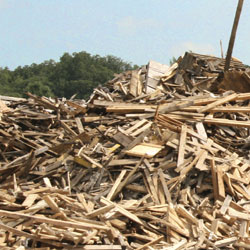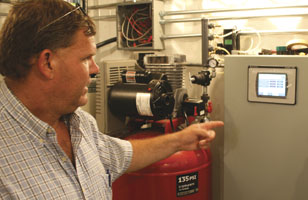
With energy prices skyrocketing, America is looking for alternatives to reduce dependence on foreign oil, lower costs and help the environment. One local company plans to step into that niche with innovative products that run on recycled natural resources.
When Hurricane Katrina ravaged the Gulf Coast, Paul Wever wanted to find a way to help. After the storm, four million cords of wood were left lying on the ground—wood which likely would end up taking up precious space in landfills.
Wever, president of Paul Wever Construction Equipment Company, Inc. (PWCE), a manufacturer of earth-moving equipment based in Goodfield, Ill., came up with a possible solution to this problem.
His idea: to start a New Generation Cooperative (NGC) to cut and process this waste wood for use in the Upper Mississippi River Valley region. An NGC is a federal program used primarily in the value-added processing of agricultural commodities, with start-up costs partially funded by the government. Many ethanol plants operate as NGCs.
Wever presented his plan for the wood to be processed, cut, put on barges and shipped north to be used as firewood. But after thousands of hours of research and four trips to Mississippi, he came back empty-handed, unable to secure interested parties to help with the project. His original plans thwarted, Wever began looking for ways to better utilize waste stream wood for energy.
The Chips Fall into Place
That’s when he met Dr. Paul Anderson of Normal, a retired geography professor from Illinois State University who was working on a cooking stove for third world countries that involved the technique of gasification. Anderson showed Wever a small, primitive gasifier that impressed him and left him wanting to know more.
The two were a perfect match. Anderson had knowledge of the technique, and Wever had the equipment and know-how to build a commercial product. In 2008, the two founded Chip Energy, a company committed to building innovative products that run on recycled natural resources. Their initial product was the Biomass Stove/Grill. Based on Anderson’s cooking stove, the small appliance cooks meals using any dry biomass as fuel. Next, Chip Energy began developing a Biomass Furnace, a larger industrial system capable of effectively heating buildings using any biomass fuel.
An Important Investor
To commercialize the Biomass Furnace, the company needed outside funding. That’s when the Environmental Protection Agency (EPA) took notice. Once or twice a year, the EPA publishes requests for proposals for their Small Business Innovation Research Program (SBIR). Chip Energy sent a proposal, and about eight months later, the company became a recipient of the SBIR Phase I Grant. A preliminary six-month contract was attached to the grant, under which Chip Energy is currently working to automate the furnace’s functions, build a user-friendly interface and measure emissions content and combustion efficiency levels.
After the contract expires—and if the prototype proves itself—the company will be eligible for Phase II of the program, under which they would receive an extended contract and up to $235,000 of grant money to further the commercialization of the furnace. 
Expanding Biomass Options
“Chip Energy is not the first company to attempt commercialization of gasification technology,” explained Wever. “It is very popular in Europe for wood pellet fuel to be used for home heating, using different types of gasification.” But current biomass heating systems focus on cordwood, wood pellets and corn—a limited assortment of options not universally available. Chip Energy will broaden that pallet of alternatives, utilizing a variety of biomass fuels that are abundant and locally available.
The Biomass Furnace can use any type of dry biomass processed in an appropriate ‘chip’ size that can pass through the fuel system. Biomass is defined as any fuel source derived from a once-living organism. The furnace can run on 50 to 100 different types of biomass, including wood chips, rice husks, switch grass, cherry pits, paper shreds, peanut shells and leaves.
Chip Energy currently uses wood as its primary fuel. The company is under contract to collect and recycle scrap wood from Caterpillar’s nearby factories, and also has contracts with Parsons Manufacturing in Roanoke and Washington Equipment in Eureka. Once this waste wood is chipped, it makes the perfect fuel for the furnace.
The furnace itself is a self-contained unit that requires no foundation, roof or concrete slab—just four points of contact. It can run for 10 to 14 days with no stoking or attending. “That’s what’s unique about what we’re doing versus what others are doing,” Wever said. He explained that, presently, you can buy an outdoor furnace, but it requires an attendant to put wood into the system twice a day.
Chip Energy plans to sell fuel contracts with the furnaces, guaranteeing a certain price for an entire heating season and delivering the fuel to your doorstep. “The person who wants to be green but doesn’t want to touch a chainsaw—that’s my target market,” Wever said.
The Micro-Gasification Process
Chip Energy uses the technique of gasification to transform biomass into heat. When dry biomass fuel is burned, the solid fuel is converted into its component combustible gases. When the making of those gases is separate from where they are combusted, the process is called gasification.
Large-scale gasification has been around for nearly two centuries, but the two forms of small-scale gasification, called micro-gasification, were not practical or commercially available until several years ago.
As Wever explained, the act of striking a match is an example of gasification: you’re turning a solid piece of fuel—the match—into a gas as it burns. The difference is that Chip’s micro-gasifiers keep the fuel in gas form and temporarily starve it for oxygen to prevent combustion. That potent gas is then directed to a combustor where it is mixed with oxygen and combusted, with extremely low emissions. The Biomass Furnace is a smokeless system—gases are still emitted, but there is no visible particulate matter.
After the biomass is combusted, an ash byproduct is deposited into a barrel connected to the furnace. That ash will then be removed by Chip Energy if you have a fuel delivery contract. The ash is not taken to a landfill—it can be used as fertilizer or converted into carbon black. Carbon black has several industrial uses—it’s what makes up charcoal; it’s also what makes hockey pucks black.
Supplementing Peak Flow
The Biomass Furnace is meant to supplement, not replace, existing heating systems. When it is added to an existing heating system, the furnace should provide 80 percent or more of the heat, reducing the use of fossil fuels and the greenhouse gases they emit.
Heating systems are designed based on a peak flow—peak being when it’s coldest outside. Chip Energy’s furnace is designed to handle everything but that peak period. “We’re using the cheaper fuel every day, and on the days where it gets really cold, then the natural gas will kick in,” Wever explained.
For example, Wever pays between $1,200 and $1,500 a month during peak winter season—about four months—to heat the PWCE facility. With a Biomass Furnace installed, he estimates that he will be able to heat the facility for that same amount for the entire heating season.
The Next Exxon?
Chip Energy will serve as the marketing arm for the Biomass Furnace and its other products, and PWCE will handle the manufacturing end. The company’s primary target market for the Biomass Furnace is light-commercial industry. Wever plans to offer a smaller version of the furnace for residential use as well.
Wever’s long-term vision for Chip Energy is to be a small part of a large energy company. “We hope that, someday, somebody will be comparing Exxon and Chip Energy.” Lofty goals, to be sure. But Wever’s story is an example of American ingenuity at its finest—the kind that will help solve our nation’s more intractable problems and put us on a course of energy independence and environmental sustainability in the 21st century. For more information, visit www.chipenergy.com. iBi

